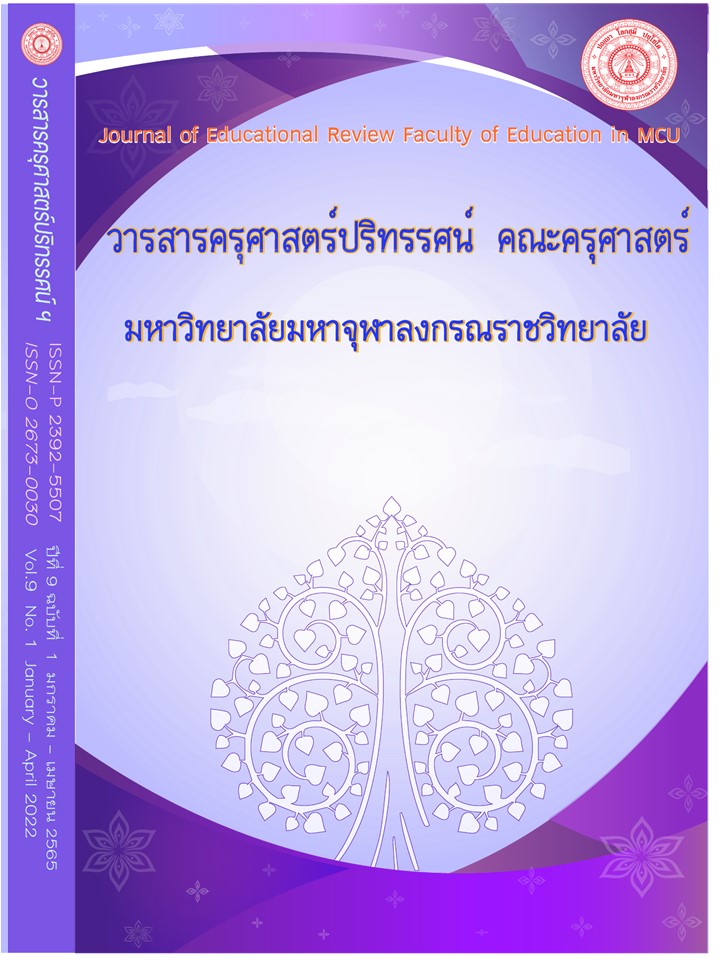THE GUIDELINES FOR THE DEVELOPMENT OF SCIENCE INSTRUCTION WITH LEARNER-CENTERED METHOD IN ACCORDANCE WITH THE FOUR NOBLE TRUTHS OF TEACHERS UNDER THE OFFICE OF SECONDARY EDUCATIONAL SERVICE AREAS 3, PHRA NAKHON SI AYAUTTHAYA PROVINCE
Main Article Content
Abstract
The objectives of this research were: 1) to study the state of science instruction with learner-centered method, 2) to study development method of science instruction management with learner-centered method based on the principles of the Four Noble Truths, and 3) to propose guidelines for development of science instruction management with learner-centered method based on the principles of the Four Noble Truths of teachers under Office of Secondary Educational Service Area 3, Phra Nakhon Si Ayutthaya province. Mixed methods research was used for the study. 1) Quantitative research, questionnaires was used to collect data from 357 samples, and data were analyzed by descriptive statistics consisted of percentage, mean and standard deviation. 2) Qualitative research, data was collected by interviews with 5 key informants and data was analyzed by content analysis. Results of the study found that: 1) the state of science instruction with learner-centered method in 5 steps was at a high level overall; in paying attention, explanation and conclusion, evaluation, search and research, and knowledge expansion. 2) The development method of science instruction management with learner-centered method based on the principles of the Four Noble Truths consists of; (1) identify and scope the problem (Dukkha) that come from science studies, (2) set a hypothesis, (Samudaya)by setting collaborative learning, (3) data collection and experiment (Magga) by using teaching and learning media, and (4) analysis and conclusion (Nirodha) by setting self-directed learning. 3) Guidelines for development of science instruction management with learner-centered method based on the principles of the Four Noble Truths of teachers are as follows: (1) Dukkha, identify and scope the problem from the instruction, (2) Samudaya, set a hypothesis, applied innovation and technology in teaching, (3) Magga, experiment and data collection, using teamwork and recording, and (4) Nirodha, analysis and conclusion including pre-test, formative and summative assessment with authentic assessment.
Article Details

This work is licensed under a Creative Commons Attribution-NonCommercial-NoDerivatives 4.0 International License.
ทัศนะและความคิดเห็นที่ปรากฏในบทความในวารสารฉบับนี้ถือเป็นความรับผิดชอบของผู้เขียนบทความนั้นเพียงผู้เดียว และไม่ถือเป็นทัศนะและความรับผิดชอบของกองบรรณาธิการ
กองบรรณาธิการขอสงวนสิทธิ์ในการคัดเลือกบทความลงตีพิมพ์และจะแจ้งให้เจ้าของบทความทราบหลังจากผู้ประเมินบทความตรวจอ่านบทความแล้ว
ต้นฉบับที่ได้รับการตีพิมพ์ในวารสารครุศาสตร์ปริทรรศน์ คณะครุศาสตร์ มหาวิทยาลัยมหาจุฬาลงกรณราชวิทยาลัย ถือเป็นกรรมสิทธิ์ของคณะครุศาสตร์ มหาวิทยาลัยมหาจุฬาลงกรณราชวิทยาลัย ห้ามนำข้อความทั้งหมดหรือบางส่วนไปพิมพ์ซ้ำ เว้นเสียแต่ว่าจะได้รับอนุญาตจากมหาวิทยาลัยฯ เป็นลายลักษณ์อักษร
References
กระทรวงศึกษาธิการ. (2545). พระราชบัญญัติการศึกษาแห่งชาติ พ.ศ. 2542 และที่แก้ไขเพิ่มเติม (ฉบับที่ 2) พ.ศ. 2545. กรุงเทพมหานคร: พริกหวานกราฟฟิค.
ธานินทร์ ศิลป์จารุ. (2551). การวิจัยและวิเคราะห์ข้อมูลทางสถิติด้วย SPSS. พิมพ์ครั้งที่ 9. กรุงเทพมหานคร: เอส.อาร์.พริ้นติ้งแมสโปรดักส์.
พระมหากิตติพงษ์ ภูมิรา. (2561). การศึกษาผลสัมฤทธิ์ทางการเรียนสังคมศึกษาและความสามารถในการคิดอย่างมีวิจารณญาณ ของสามเณรในโรงเรียนพระปริยัติธรรมแผนกสามัญศึกษาที่เรียนโดยการจัดการเรียนรู้แบบอริยสัจกับการจัดการเรียนรู้แบบบูรณาการ. วิทยานิพนธ์การศึกษามหาบัณฑิต. มหาวิทยาลัยศรีนครินทรวิโรฒ.
พระมหาญาณวัฒน์ ฐิตวฑฺฒโน (บุดดาวงษ์) และอชิรญา ภู่พงศกร. (2559). นโยบายการศึกษาตามแผนพัฒนาเศรษฐกิจและสังคมแห่งชาติ. วารสารครุศาสตร์ปริทรรศน์ คณะครุศาสตร์ มหาวิทยาลัยมหาจุฬาลงกรณราชวิทยาลัย. 3(3). 30-46.
พระสมบัติ ไกรอ่ำ. (2550). การพัฒนาแผนการจัดการเรียนรู้ กลุ่มสาระสังคมศึกษา ศาสนาและวัฒนธรรมเรื่อง หลักธรรมทางพระพุทธศาสนาชั้นมัธยมศึกษาปีที่ 3 โดยใช้วิธีสอนแบบอริยสัจสี่. วิทยานิพนธ์การศึกษามหาบัณฑิต. มหาวิทยาลัยมหาสารคาม.
มนตรี กรมทำมา. (2560). การพัฒนาทักษะการแก้ปัญหาและผลสัมฤทธิ์ทางการเรียน กลุ่มสาระ การเรียนรู้สังคมศึกษา ศาสนาและวัฒนธรรม สาระที่ 3 เศรษฐศาสตร์ โดยใช้รูปแบบการสอนอริยสัจสี่ของนักเรียนชั้นมัธยมศึกษาปีที่ 4 โรงเรียนท่านางแนววิทยายน จังหวัดขอนแก่น. วิทยานิพนธ์ศึกษาศาสตรมหาบัณฑิต. มหาวิทยาลัยขอนแก่น.
ระพีพรรณ ดวงใจ. (2560). ผลการสอนแบบอริยสัจสี่ที่มีผลสัมฤทธิ์ทางการเรียนและทักษะการคิดแบบเห็นคุณโทษและทางออก เรื่อง หลักธรรมเพื่อพัฒนาเศรษฐกิจพอเพียง ของนักเรียนชั้นมัธยมศึกษาปีที่ 3 โรงเรียนพิมายวิทยา จังหวัดนครราชสีมา. วิทยานิพนธ์ศึกษาศาสตรมหาบัณฑิต. มหาวิทยาลัยสุโขทัยธรรมาธิราช.
สุรเกียรติ ไชยนุวัติ. (2559). การศึกษาความสามารถในการคิดวิเคราะห์ของนักเรียนชั้นมัธยมศึกษาปีที่ 2 ด้วยกระบวนการแก้ปัญหาตามหลักอริยสัจสี่. วิทยานิพนธ์ครุศาสตรมหาบัณฑิต. มหาวิทยาลัยราชภัฏรำไพพรรณี.


